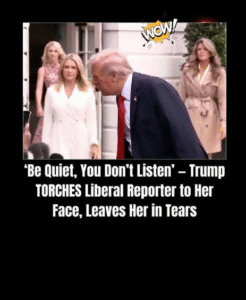Trump Snaps at Reporter Over Chicago Crime Question: A Flashpoint in the War of Words
It happened on the steps of power, just before President Donald Trump boarded a flight to the US Open. The air was thick with tension, not from weather, but from words—words that had been posted, shared, memed, and weaponized. The question was simple, but the answer ignited a firestorm.
“Are you preparing to go to war with Chicago?”
The reporter’s voice cut through the press scrum like a scalpel. It referenced a meme Trump had posted the day before—an Apocalypse Now-style image with the caption: “I love the smell of deportations in the morning. Chicago is about to find out why it’s called the Department of WAR.”
Trump’s response was immediate and sharp.
“When you say that, darling, that’s fake news,” he snapped. The word “darling” wasn’t affectionate—it was dismissive, condescending, a rhetorical slap. And it didn’t end there.
“Be quiet, listen! You don’t listen! You never listen. That’s why you’re second-rate,” he continued, cutting off the reporter mid-question.
The moment was captured on video, dissected on social media, and debated across newsrooms. But beneath the spectacle lay deeper questions: What does it mean when a president calls a city a war zone? What happens when rhetoric becomes policy? And who gets to define “fake news”?
🔥 The Meme That Sparked It All
Trump’s meme wasn’t just provocative—it was strategic. By renaming the Pentagon the “Department of War,” he signaled a shift in tone, a return to muscular nationalism. The image of Chicago burning, paired with a slogan borrowed from cinematic warfare, wasn’t accidental. It was a message: crime will be met with force.
The meme followed a series of statements in which Trump floated deploying the National Guard to cities like Chicago, Baltimore, and New Orleans to combat violent crime. He had already sent troops to Washington, D.C., and taken control of the city’s police department. Legal challenges were mounting, but the message was clear: federal muscle would override local resistance.
🗣️ The Reporter’s Role
The journalist who asked the question wasn’t just probing policy—she was challenging the narrative. By framing the meme as a declaration of war, she forced Trump to confront the implications of his own words. And that’s where the tension exploded.
Trump’s reaction—calling her “second-rate,” telling her to “be quiet”—wasn’t just personal. It was political. It was a rebuke of the press, a dismissal of dissent, and a reinforcement of his preferred reality.
In that moment, the press wasn’t just reporting on power—it was being punished by it.
🏙️ Why Chicago?
Trump’s fixation on Chicago isn’t new. He’s long cited the city’s homicide rates as evidence of Democratic failure. “Do you know how many people were killed in Chicago last weekend? Eight. The week before? Seven. Do you know how many were wounded? Seventy-four people,” he said during the exchange.
But critics argue that the focus on Chicago is selective. Other cities have higher crime rates, yet receive less attention. Illinois Governor J.B. Pritzker called Trump’s comments a “hellhole” insult and vowed to resist federal intervention.
The clash between Trump and Chicago isn’t just about crime—it’s about control. It’s about who gets to define safety, who gets to enforce it, and who gets to resist.
⚖️ Legal and Political Fallout
Trump’s threats to deploy the National Guard without state approval have already faced legal challenges. A federal judge ruled that his actions in Los Angeles violated the law. If he proceeds with plans for Chicago, similar lawsuits are likely.
Politically, the move sets up a showdown between Trump and Democratic governors. It’s a test of federal authority, state sovereignty, and the limits of executive power.
And for the public, it’s a reminder that memes aren’t just jokes—they’re signals. They shape perception, drive policy, and sometimes, spark conflict.
📸 The Optics of Outrage
The image of Trump snapping at a reporter is more than a viral clip—it’s a symbol. It captures the tension between media and power, truth and spin, accountability and deflection.
In calling the question “fake news,” Trump wasn’t just denying the premise—he was asserting control over the narrative. And in doing so, he reminded the world that in his administration, perception is policy.
But the reporter’s question still hangs in the air: Is this war?
Trump says no. “We’re not going to war, we’re gonna clean up our cities. That’s not war, that’s common sense,” he insisted.
Yet the language, the imagery, the threats—they tell a different story.
🧠 The Psychology of Power
Trump’s reaction reveals a lot about his approach to criticism. He doesn’t deflect—he attacks. He doesn’t clarify—he dominates. And in doing so, he turns every question into a contest.
Calling a reporter “second-rate” isn’t just an insult—it’s a tactic. It undermines credibility, shifts focus, and rallies supporters. It’s not about the facts—it’s about the fight.
And in that fight, Chicago becomes a symbol. Not of crime, but of resistance. Not of failure, but of friction.
🧵 Final Thoughts
The moment Trump snapped at the reporter wasn’t just a flash of temper—it was a flashpoint in a larger battle. A battle over truth, over cities, over who gets to speak and who gets silenced.
Chicago may not be at war. But the war of words is real. And in that war, every meme, every question, every snap matters.



